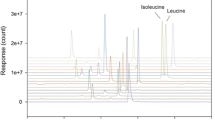Abstract
High-throughput/low-cost/low-tech methods for phytic acid determination that are sufficiently accurate and reproducible would be of value in plant genetics, crop breeding and in the food and feed industries. Variants of two candidate methods, those described by Vaintraub and Lapteva (Anal Biochem 175:227–24, 1988; “VL” methods) and Huang and Lantzsch (J Sci Food Agric 34:1423–1426, 1983; “HL” methods), were evaluated. The primary concern with these methods is that, due to interference of matrix constituents including inorganic P, they can overestimate phytic acid and are ineffective at low levels of phytic acid. Twelve seed flours, representing lines of soybean, maize, barley and dry bean, containing a wide range of phytic acid levels, were analyzed by a minimum of eight cooperating laboratories using three variants of the VL method and two variants of the HL method. No method had consistently acceptable (˂2.0”) “Horwitz ratios”, a measure of reproducibility, although some treatments approached that. For example, one variant of the VL method when used to assay a soybean flour with a “standard” level of phytic acid had a Horwitz ratio of 2.15. Some variants of the VL method were adequate for analyses of cereal grains regardless of phytic acid level but none accurately measured phytic acid when at low levels in soybean flours. One variant of the HL method in which the 0.2 N HCl extraction media is modified to contain 10% Na2SO4, did accurately measure phytic acid levels in both cereal and legume flours regardless of endogenous phytic acid levels or matrix constituents.

Similar content being viewed by others
References
Lott JNA, Ockenden I, Raboy V, Batten GD (2000) Phytic acid and phosphorus in crop seeds and fruits: a global estimate. Seed Sci Res 10:11–33
Reddy NR, Pierson MD, Sathe SK, Salunkhe DK (1989) Phytates in cereals and legumes. CRC Press Inc, Boca Raton
Cichy KA, Raboy V (2008) Evaluation and development of low phytate crops. In: Krishnan H (ed) Modification of seed composition to promote health and nutrition., Agronomy monograph seriesAmerican Society of Agronomy and Crop Science Society of America, Madison, pp 177–200
Raboy V (2006) Seed phosphorus and the development of low-phytate crops. In: Turner BL, Richardson AE, Mullaney EJ (eds) Inositol phosphates: linking agriculture and environment. CAB International, Oxfordshire, pp 111–132
Hurrell RF (2003) Influence of vegetable protein sources on trace element and mineral bioavailability. J Nutr 133:2973S–2977S
Graf E, Epson KL, Eaton JW (1987) Phytic acid: a natural antioxidant. J Biol Chem 262:11647–11650
Grases F, Ramis M, Costa-Bauzá A (2000) Effects of phytate and pyrophosphate on brushite and hydroxyapatite crystallization. Urol Res 28:136–140
Shamsuddin AM (2002) Anti-cancer function of phytic acid. Int J Food Sci Tech 37:769–782
Kwanyuen P, Burton JW (2005) A simple and rapid procedure for phytate determination in soybean and soybean products. J Am Oil Chem Soc 82:81–85
Carlsson NG, Bergman EL, Skoglund E, Hasselblad K, Sandberg AS (2001) Rapid analysis of inositol phosphates. J Agric Food Chem 49:1695–1701
Dorsch JA, Cook A, Young KA, Anderson JM, Bauman AT, Volkmann CJ, Murthy PPN, Raboy V (2003) Seed phosphorus and inositol phosphate phenotype of barley low phytic acid genotypes. Phytochemistry 62:691–706
Harland BF, Oberleas D (1986) Anion-exchange method for determination of phytate in foods: collaborative study. J Assoc Off Anal Chem 69:667–670
Raboy V, Dickinson DB, Below FE (1984) Variation in seed total P, phytic acid, zinc, calcium, magnesium, and protein among lines of Glycine max and G. soja. Crop Sci 24:431–434
Vaintraub IA, Lapteva NA (1988) Colorimetric determination of phytate in unpurified extracts of seeds and the products of their processing. Anal Biochem 175:227–230
Latta M, Eskin M (1980) A simple and rapid colorimetric determination of phytate determination. J Agric Food Chem 28:1313–1315
Haug W, Lantzsch H-J (1983) Sensitive method for the rapid determination of phytate in cereals and cereal products. J Sci Food Agric 34:1423–1426
Fruhbeck G, Alonso R, Marzo F, Santidrian S (1995) A modified method for the indirect quantitative analysis of phytate in foodstuffs. Anal Biochem 225:206–212
Gao Y, Shang C, Saghai Maroof MA, Biyashev RM, Grabau EA, Kwanyuen P, Burton JW, Buss GR (2007) A modified colorimetric method for phytic acid analysis in soybean. Crop Sci 47:1797–1803
Thompson DB, Erdman JW Jr (1982) Phytic acid determination in soybean. J Food Sci 47:513–517
Raboy V, Gerbasi PF, Young KA, Stoneburg SD, Pickett SG, Bauman AT, Murthy PN, Sheridan WF, Ertl DS (2000) Origin and seed phenotype of maize low phytic acid 1-1 and low phytic acid 2-1. Plant Physiol 124:355–368
Bilyeu KD, Zeng P, Coello P, Zangh ZJ, Krishnan HB, Beuselinck PR, Polacco JC (2008) Quantitative conversion of phytate to utilizable phosphorus in soybean seeds expressing a bacterial phytase. Plant Physiol 146:468–477
Bohn L, Josefsen L, Meyer A, Sasmussen SK (2007) Quantitative analysis of phytate globoids isolated from wheat bran and characterization of their sequential dephosphorylation by wheat phytase. J Agric Food Chem 55:7547–7552
Horwitz W, Albert R (2006) The Horwitz ratio (HorRat): a useful index of method performance with respect to precision. J AOAC Int 89:1095–1109
AOAC International (1995) Guidelines for collaborative study procedures to validate characteristics of a method of analysis. J AOAC Int 78:143A–160A
Bland JM, Altman DG (1986) Statistical methods for assessing agreement between two methods of clinical measurement. Lancet 327:307–310
Gauch HG Jr, Hwang JTG, Fick GW (2003) Model evaluation by comparison of model-based predictions and measured values. Agron J 95:1442–1446
Acknowledegments
This research was supported in part by funding provided by the United Soybean Board (Chesterfield, MO). VR would like to thank Amanda Harvey for her excellent support in the preparation of flours and reagents necessary for this study. SKR would like to thank Anja Hecht Ivø for technical support.
Author information
Authors and Affiliations
Corresponding author
Ethics declarations
Conflict of interest
The authors declare no conflict of interest.
About this article
Cite this article
Raboy, V., Johnson, A., Bilyeu, K. et al. Evaluation of Simple and Inexpensive High-Throughput Methods for Phytic Acid Determination. J Am Oil Chem Soc 94, 353–362 (2017). https://doi.org/10.1007/s11746-016-2946-y
Received:
Revised:
Accepted:
Published:
Issue Date:
DOI: https://doi.org/10.1007/s11746-016-2946-y




